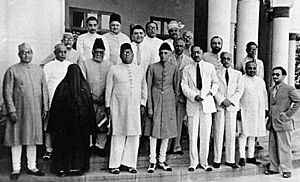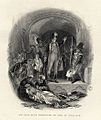Pakistan Movement facts for kids
The Pakistan Movement (also called Tehrik-e-Pakistan, Urdu: تحریکِ پاکستان) was a political movement active during the early 1900s. At that time, British India was ruled by Great Britain. Most people in British India were Hindu, and a smaller number were Muslim.
The people who started this movement were worried about losing their freedom when the British left. They wanted to create a separate country for Muslims. This effort was organized by the All-India Muslim League party. It led to the division of the British Empire in India. The movement was led by Quaid-e-Azam Muhammad Ali Jinnah. Other important leaders included Nawab Muhammad Ismail Khan, Fatima Jinnah, and Liaquat Ali Khan.
Contents
How the Pakistan Movement Started
The idea of a separate country for Muslims was first thought of by people like Sir Syed Ahmad Khan in the United Provinces of India. This was much earlier than many people realize. From 1901 onwards, many other Muslim thinkers also suggested the idea of a separate Muslim state in the region.
Choudhary Rahmat Ali later suggested the name Pakistan in his "Pakistan Declaration" in 1933. Leaders like Muhammad Ali Jinnah initially believed in religious unity. However, growing conflicts between Hindus and Muslims gave the movement stronger support.
In 1940, during a meeting in Lahore, the Muslim League passed the Lahore Resolution. This important resolution asked for an independent state called Pakistan. After World War II, the United Kingdom realized it could not keep its colonies in South Asia. The British Empire had suffered greatly from the war. By 1947, British India was divided into two countries: Pakistan, with a majority of Muslims, and India, with a majority of Hindus. Later, Bangladesh separated from Pakistan in 1971.
Key Dates in the Movement
|
|
See Also
Images for kids
-
Minar e Pakistan, where the bill of Lahore Resolution was passed.
-
Robert Clive meeting with Emperor Shah Alam II, 1765.
-
The Muslim League Governing Council at the Lahore session. The woman wearing the black cloak is Muhatarma Amjadi Banu Begum, the wife of Mohammad Ali Jauhar, a prominent Muslim League leader. Begum was a leading representative of the UP's Muslim women during the years of the Pakistan Movement.
-
Nawab Mohsin ul Mulk,(left) who organised the Simla deputation, with Sir Syed Ahmed Khan (Centre), Sir Syed's son Justice Syed Mahmood (extreme right). Syed Mahmood was the first Muslim to serve as a High Court judge in the British Raj.
-
Robert Clive meeting with Mir Jafar after the Battle of Plassey.
See also
 In Spanish: Movimiento por Pakistán para niños
In Spanish: Movimiento por Pakistán para niños










